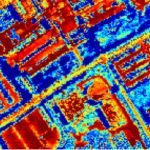Abstract: This paper develops an anomaly detection algorithm for subsurface object detection using the handheld ground penetrating radar. The algorithm is based on the Mahalanobis distance measure with adaptive update of the background statistics. It processes the data sequentially for… Read More
PublicationPublication
Functions of multiple instances for sub-pixel target characterization in hyperspectral imagery
Abstract: In this paper, the Multi-target Extended Function of Multiple Instances (Multi-target eFUMI) method is developed and described. The method is capable of learning multiple target spectral signatures from weakly- and inaccurately-labeled hyperspectral imagery. Multi-target eFUMI is a generalization of… Read More
Multiple instance dictionary learning for subsurface object detection using handheld EMI
Abstract: A dictionary learning approach for subsurface object detection using handheld electromagnetic induction (EMI) data is presented. A large number of unsupervised and supervised dictionary learning methods have been developed in the literature. However, the majority of these methods require… Read More
Endmember representation of human geography layers
Abstract: This paper presents an endmember estimation and representation approach for human geography data cubes. Human-related factors that can be mapped for a geographic region include factors relating to population, age, religion, education, medical access and others. Given these hundreds… Read More
A human geospatial predictive analytics framework with application to finding medically underserved areas
Abstract: Human geography is a concept used to indicate the augmentation of standard geographic layers of information about an area with behavioral variations of the people in the area. In particular, the actions of people can be attributed to both… Read More
Invariant parameter estimation across varying seabeds in synthetic aperture sonar imagery
Abstract: Side-look synthetic aperture sonar (SAS) can produce very high quality images of the seabed. The imagery generated by SAS sensors display the seafloor and associated textures, such as sand ripples or seagrass. The characterization of SAS imagery is important… Read More
Boundary detection and Superpixel formation in synthetic aperture sonar imagery
Abstract: A boundary detection algorithm for synthetic aper- ture sonar (SAS) images that draws upon a popular superpixel formation algorithm is detailed and tested against a set of SAS images containing a variety of common seabed categories. Textural clues are… Read More
Sparsity promoted non-negative matrix factorization for source separation and detection
Abstract: The effectiveness of non-negative matrix factorization (NMF) depends on a suitable choice of the number of bases, which is often difficult to decide in practice. This paper imposes sparseness on the factorization coefficients in order to determine the number… Read More
Spatial and spectral unmixing using the beta compositional model

Abstract: This paper introduces the beta compositional model (BCM) for hyperspectral unmixing and four algorithms for unmixing given the BCM. Hyperspectral unmixing estimates the proportion of each endmember at every pixel of a hyperspectral image. Under the BCM, each endmember… Read More
An integrated graph cuts segmentation and piece-wise convex unmixing approach for hyperspectral imaging
Abstract: Context-based unmixing has been studied by several researchers. Recent techniques, such as piece-wise convex unmixing using fuzzy and possibilistic clustering or Bayesian methods proposed in [11] attempt to form contexts via clustering. It is assumed that the linear mixing… Read More